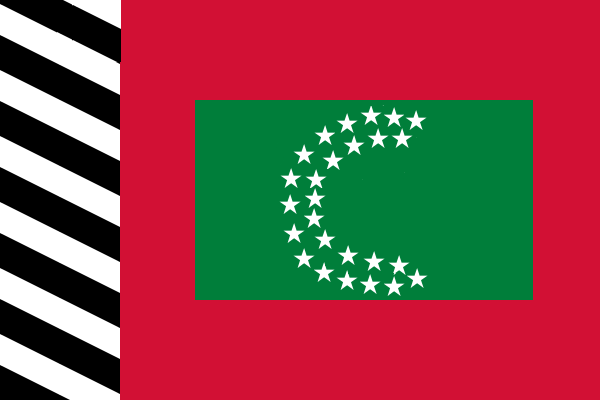BY LETTER
Maldives
History > 0030 to 0900 AT: Solsys Era > 130 to 400 AT: The Interplanetary Age
History > 0030 to 0900 AT: Solsys Era > 400 to 530 AT: The Solsys Golden Age
History > 0030 to 0900 AT: Solsys Era > 530 to 900 AT: The Sundering
Galactography > Historical Polities
Galactography > Places and Locales
History > 0030 to 0900 AT: Solsys Era > 400 to 530 AT: The Solsys Golden Age
History > 0030 to 0900 AT: Solsys Era > 530 to 900 AT: The Sundering
Galactography > Historical Polities
Galactography > Places and Locales
Nation-state of Old Earth | |
 Image from MacGregor | |
| Flag of the United Republic of the Maldives and Associated Territories, adopted in 233 AT | |
An archipelago and nation state of Old Earth located in the Indian Ocean. Composed of nearly 1,200 islands arranged in 26 atolls, the Maldives sit on a north-south running ridge called the Chagos-Laccadive Plateau. The Maldives are extremely low lying with the highest natural point less than 2.5 meters in elevation.
The Maldives remained a relatively unimportant backwater for much of its early history. During the 1100s CE (870-770 BT) the islands' predominantly Buddhist inhabitants were Islamized by Arab travelers. King Donei Kalaminjaa assumed the title of Sultan in 1153 CE (817 BT) after his conversion. The Maldives would remain a sultanate both as an independent state and later as a British protectorate until the monarchy was overthrown for good in 1968 CE (1 BT). The Republic of Maldives would struggle for the next century with political instability, poverty, and rising sea levels due to climate change.
Things began to turn around in the early 22nd century CE when a joint project organized by the United Nations and the South Asian Association for Regional Cooperation (SAARC) began enclosing the nation's islands in domes after rising sea levels threatened to finally overtake the local seawalls. Once completed, the beautiful climate controlled domed islands became an extremely popular tourist attraction, enabling the Maldives to break the crippling poverty that had long affected the nation. Money from tourism allowed the nation to invest in a host of other business ventures, transforming the Maldives into an important genetic engineering haven and regional hub for the burgeoning underwater mining industry. An underwater vac train tunnel connecting the Maldives to the Indian city of Kochi was completed in 2188 (219 AT). The period also saw a massive influx of immigrants mostly from South Asia, the Middle East, and Africa leading to a diverse but ultimately Hindu dominated culture. Unsurprisingly, the Maldives attracted a significant number of merpeople and other aquatic tweaks. By the end of the century, the once sparsely populated islands had been transformed into an interconnected network of arcologies, resorts, and underwater facilities. In 2202 (233 AT), the government, now styled officially as the United Republic of the Maldives and Associated Territories, was reorganized to better embrace the nation's diverse citizenry and expansive holdings.
In 2217 (248 AT), the Maldives became a founding member of the South Asian Compact (SAC), a new supranational organization promoting regional integration and development. One of SAC's main efforts was to oversee the construction of a beanstalk to service South Asia. With the Maldives straddling the equator, it was the natural site to begin construction. Completed in 2243 (274 AT), the Vahana Space Elevator would be the sixth and last Earth beanstalk before the Technocalypse. However, despite hosting a beanstalk the Maldives never developed a large presence in space like neighboring India and Pakistan. Nevertheless, the Vahana Space Elevator, gene-modding, underwater mining, and the slow shift of economic clout from the global North to the South made the Maldives into an important, but by no means dominant, regional power.
Over the subsequent centuries, the Maldives continued to grow and expand its underwater infrastructure. This included building a large number of Ocean Thermal Energy Conversion (OTEC) power plants for domestic use and later export to the rest of the SAC. In the 24th and 25th centuries CE the Maldives, like most Earth nations, slowly lost influence with the growth of various space-based polities and corporate conglomerates in the Solar System. As temperatures cooled on hothouse Earth and sea levels fell the domes proved to be less necessary but were kept as historical artifacts.
Along with most of the Indian subcontinent, the Technocalypse would devastate the Maldives. Initially, it was hoped that by destroying the vac-train tunnels and increasing their defenses the islands would be spared from the worst. However, once the swarms breached the enclosures casualties skyrocketed. During the Great Expulsion, a number of Maldivian majority settlements were created in orbit. The largest was King's Island at nearly 24 km in diameter. In the Current Era, few traces of Maldivian culture continue to exist. However, some point to lingering influences in merpeople communities in Solsys and other nearby systems. The islands themselves are believed to hold a few thousand baselines and a smattering of merpeople communities.
Related Articles
Appears in Topics
| 130 to 400 AT: The Interplanetary Age | 400 to 530 AT: The Solsys Golden Age | 530 to 900 AT: The Sundering |
| Historical Polities | Places and Locales |
Development Notes
Text by MacGregor
Initially published on 07 April 2017.
Initially published on 07 April 2017.






